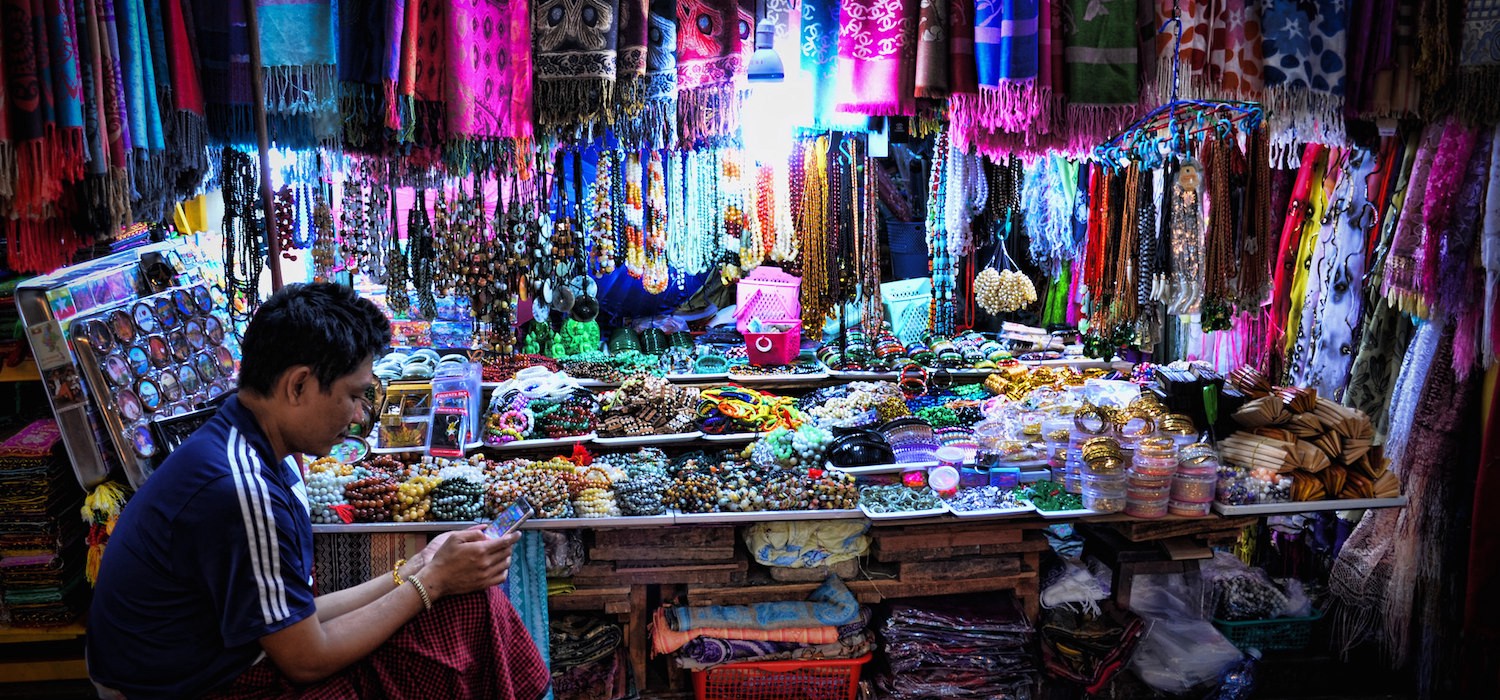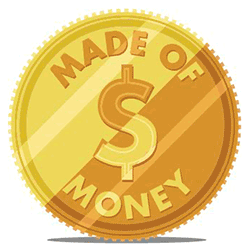

“Five years ago, I had to pay US$500 for a SIM card,” said local cab driver Kyi Moe as he sped through the crowded streets of downtown Yangon. “Now, they are 1,500 kyat.” That’s a dollar fifty in U.S. currency.
In just over two years, the country of Myanmar (formerly known as Burma) has transformed from one of the least connected places on Earth–comparable to North Korea–in to a nation of cell phones users. Its mobile phone penetration rate is over 50 percent.
Meanwhile, only about five percent of its population has a bank account. The majority of Burmese citizens still do not trust banks. Cash remains the preferable choice: both the official and often-tattered local kyat notes and the informal use of pristine U.S. dollars.
Whether mobile money banking could change all this is what I’ve come to Yangon to find out.

“Banking penetration in Myanmar is about 3.1 bank branches per 100,000 population. That’s the same level of bank penetration as Haiti, Afghanistan, and South Sudan,” said Brad Jones, who has worked in executive roles in the emerging payments industries in Asia Pacific, the Middle East, and Australia for the last 15 years. His specialty is establishing startups in developing markets.
“What mobile money does, firstly, is to provide an account to customers who would otherwise be ignored by the banks,” said Jones. He is currently the CEO of Wave Money, a recently launched mobile money initiative between the Norwegian telecoms giant Telenor and the Burmese Yoma Bank.
Two billion adults worldwide lack access to banking or formal financial services. Being “unbanked” means having no access to basic tools–including investment accounts, insurance, or credit. Instead, people depend on accumulating tangible assets (such as cash or jewelry) or rely on informal lenders and financial couriers. In Myanmar, locals told me, “You buy gold or real estate.” Informal peer savings and credit groups are another alternative.
The advent of mobile phones–which with over 7.7 billion connections globally are more numerous than humans–is increasingly touted as a vehicle for financial inclusion. Given recent innovations in digital payment security, phones are proving to be a cost-effective way of providing access to rudimentary financial services where banks just aren’t part of the landscape.
The World Bank specifically credits evolving technology in helping to spur a 20 percent drop in the number of unbanked adults between 2011 and 2014. The mobile carrier industry alliance GSMA reports that mobile money is now accessible in 93 countries worldwide, with over 134 million active user accounts. That includes 85 percent of those countries where less than 20 percent of their populations hold conventional bank accounts.
In Myanmar, apart from several small-scale pilot projects, mobile financial services only began in 2015. That same year, Myanmar was the fourth fastest growing mobile phone market in the world–trailing only China, India, and the United States.

“It’s only recently that I got a bank account. Banking is seen as something for the elites. I would be surprised if many young people had bank accounts,” said Wai Phyo Maung, a 26-year-old librarian. Many in Yangon, Myanmar’s largest city, echoed the sentiment.
Repeatedly and without warning during its six decades of military rule, Myanmar’s government demonetized Kyat-denominated currencies: Many saw their savings become worthless quite literally overnight. In 2003, a financial crisis tore through the country’s existing banking sector, prompting the implosion of several of its largest financial institutions. All this is compounded by the cumbersomeness of Myanmar’s retail banking services, which remain both sparse and typically accessible only from 9:30 a.m. to 3 p.m.
Just two years ago, state-owned Myanmar Posts and Telecommunications (MPT) was finally forced to relinquish its decades-long absolute monopoly over telecommunications in the country, allowing for the entrance of foreign firms Telenor and Ooredoo. The cost of SIM cards, which had been upwards of US$2,000 in 2010 (due to artificial caps imposed by the military junta) has since stabilized to $1.50. Similarly, the price of mobile data radically and quickly dropped.
Still, the developing world has yet to see a one-size-fits-all, easily exportable mobile money system. The “poster child” and global leader for mobile money is undoubtedly Kenya, where over two-thirds of the country’s population has already made use of the virtual currency M-Pesa. Launched in 2007, the mobile money-transfer service allows its users to make or receive payments via text messages. Still, many other mobile banking schemes have failed for technical, regulatory, or societal reasons. Even Kenya’s neighboring countries have proved unable to replicate the same degree of success with M-pesa. Quite a few apps have also been shown to have notable encryption flaws vulnerable to attackers looking to steal funds.
Perhaps an even more pervasive issue is that women and rural customers remain critically underserved by mobile money services, with a global median penetration of 37 percent and 47.3 percent, respectively, in 2015. Women in Myanmar remain 29 percent less likely than men to own a mobile phone, according to a recent survey conducted by LIRNEasia and GSMA Connected Women.
The gender gap is particularly troubling as access to a savings account has proved to be an important stepping stone out of poverty and toward greater equality for low-income women.
Myanmar itself stands out as a market ripe with opportunity for mobile bank providers because many first-time cellphone buyers have taken to smartphones, leapfrogging over less capable feature phones completely. Companies MPT and Ooredoo report that 80″”90 percent of their clients are on smartphones, while Telenor has indicated that 6 out of 10 of its clients are. By comparison, the United States has a 77 percent smartphone usage rate.
Telenor, which had originally committed to a 2G-system rollout, revised its entire Myanmar business strategy to focus on building 3G towers: enabling a network capacity compatible with the comparatively voracious data throughput demand. Ooredoo has pursued a similar path. There are now regions in Myanmar which have extensive 3G coverage but still lack running water and reliable electricity.
“The acceleration of data and smartphones–and the familiarity here–it’s taken everybody by surprise,” said Jones. “I’ve worked across mobile money in a lot of markets, including in Africa and Asia, and I’ve never seen conditions like we’ve got here in Myanmar for really designing solutions that are customer-friendly.”
Facebook is omnipresent in the country, to the point that it is quasi-synonymous with the internet, and Burmese smartphone owners use the messaging and calling app Viber with the same ease they do the voice function. Mistrust of banks, however, remains high. Among the dozen or so Burmese I interviewed for this article, fewer than a third had bank accounts.

Still, a handful of companies are betting on mobile money as the answer. Wave Money, which initiated commercial testing four months ago, is by far the most ubiquitous–though that’s not saying a lot. It is also the only currently active mobile money initiative owned, at least in part, by a telecom firm (at 61 percent by Telenor), which gives it access to a much wider client and agent base than its competitors. MPT and Ooredoo, nevertheless, both intend to launch their own, once the Myanmar Central Bank finalizes pending mobile money regulations.
“Our accounts are free. Anyone can self-register through a phone and be activated with what is basically a cut-down bank account,” explained Jones. While Wave’s app has been designed with smartphones in mind, a basic interface is available for feature phones.
Early adopters of Wave Money, he said, have been small business people. “We don’t have [bank] branches. We use a network of small retailers. Our venues are mom-and-pop shops, tea shops, pharmacies. These are ordinarily open till 8″”9 p.m. every night and usually six days a week. Any customers can go to anyone of those shops and make a deposit or a withdrawal. We already have over 3,000 shops activated, and we are covering about 30 to 40 percent of the country,” said Jones.
Telenor, which has currently over 14 million customers, owes much of its success to its wide distribution networks, which include over 60,000 points of sale across the Myanmar. In selecting retailers, Wave Money geo-mapped those shops according to location and business performance and contacted those that were most promising. If interested, the shops then became contracted to Wave, which trains them to be agents.
“For Wave Money to be successful, we have to be able to push electronic money down to the lowest levels of our distribution networks and bring cash ultimately back to the bank. We worked with Yoma to help them design a cash management service that allows us to recycle cash and e-money down to the distributor level and then the distributors manage liquidity down to the retailers,” Jones explained.
“That capability didn’t really exist in Myanmar until we came to the service. And at the end of the day, it’s also about building something that will be of use to the financial development of the country.”
Ultimately, Jones believes that mobile money can play the role of a public service in a country like Myanmar, where internal armed conflicts continue to rage on. “We want to have the ability where we can work with government, NGOs, and the development sector to move money around the country in time of dire needs.” Is he right?

The next day, I set out to try and test Wave Money myself in downtown Yangon, accompanied by a Burmese speaker, 23-year-old Aung Htet Moe. While he himself had a bank account and was a prolific app and social media user, he is dubious about mobile money’s prospects in Myanmar.
We spoke to four retailers, including mobile vendors and snack shops. All had been Wave Money retailers for more fewer than five weeks and had yet to have any clients ask for it. The owner of a tiny watch shop was able to confidently explain how Wave works and expertly help me navigate the app.
Meanwhile, despite having the rates posted on the wall behind him, another shop owner seemed uncertain about the withdrawal process, and seemed to imply that some users would have to go to Yoma Bank with their cellphones. This will likely change as the service becomes more popular, but it highlights mobile money’s current dependency on agents to function efficiently.
Later, as we joined Aung Htet Moe’s friends at a outdoor tea shop, I noticed they all had smartphones in hand. When I mentioned Wave Money, they called it “interesting “¦ and promising in its potential to send funds across the country.” But none was willing to try it just yet.
“Only cash is really trustworthy,” they said.
And there lies mobile money’s real challenge in Myanmar. The country may have the technological capacity, but the route is a long one to convincing a wary population that virtual mobile money is as concrete as the real thing.


How We Get To Next was a magazine that explored the future of science, technology, and culture from 2014 to 2019. This article is part of our Made of Money section, which covers the future of cash, finance, economics, and trade. Click the logo to read more.
